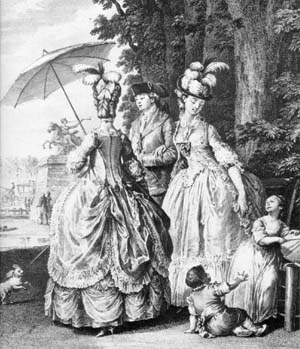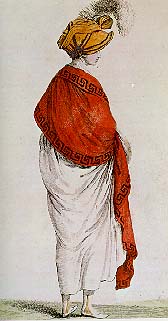Women's
Clothing
A History of English Dress in the Late 17th to 18th Centuries
click on images to find out more information
Precursors to 18th Century Feminine Attire:
The Gown: popular
until the close of the 15th century, this dress was a ground-length, one-piece
affair that succeeded best in concealing women's shapelier portions rather than
showing off their figures. It conceded to womanly shape only through a girdle
that tied at the waist of the wearer. In the early part of the 19th century,
it enjoyed a resurrection in a repeated movement towards classical values and
traditions in England. Good recreations of early 19th century gowns can be seen
in the movie adaptations of novels such as Jane Austen's Sense
& Sensibility and Pride
& Prejudice.
The Closed Dress, Two-Piece
Style: This dress was divided into two parts -- a skirt and a bodice. It
was created sometime around the Renaissance period, but was most commonly worn
during the Elizabethan times. Since the skirt was separate from the upper part
of the dress, dressmakers were able to add more form to it via pleats and gathers
(folds in the cloth that bend it in a particular direction.) Examples of this
type of garment can be found in Shakespearean plays and movie productions, the
most recent of which is Shakespeare
in Love. (Cunnington, "The Art of the English
Costume" pp. 85-86)
The Open Dress, Two-Piece Style:
Also found in Elizabethan times, these dresses, characterized by a robe-like
overdress over one or more underdresses and skirts, were initially considered
"risque" because of their resemblance to teagowns. Teagowns, which
were loose, open robes fastened with cords or ribbons, were used by pregnant
women and considered scandalous on young, unmarried ladies. However, the versatility
of the garment (mix and matching) as well as the additional acreage of cloth
that could be frilled, laced, and otherwise decorated increased its popularity.
This style lasted well through the Classical Baroque Period (early-mid 17th
century, probably best known for the frilly, stiff circular collars and formal,
equally stiff clothes that both men and women wore at court) and influenced
the dresses of both the Rococo and Neo-classical periods of the 18th century.
(Cunnington, "The Art of the English Costume"
pp. 85-86)
Rococo Period: 1690-1770
 The
beginning of the 18th century showed promise of many changes in fashion and
lifestyle of the English. By this time, the beginning of the Age of Enlightenment,
people were veering away from the ponderous though magnificent clothing of the
Classical Baroque era and towards a more proletariat stance. The traditions
of the classical eras --- the time of the ancient Greeks and Romans --- were
much admired by the new free-thinking generation, and influenced their way of
dress. Clothes became more relaxed, with a less rigid structure and an emphasis
on the natural flow of line and figure. (Squire,102-105.)
The
beginning of the 18th century showed promise of many changes in fashion and
lifestyle of the English. By this time, the beginning of the Age of Enlightenment,
people were veering away from the ponderous though magnificent clothing of the
Classical Baroque era and towards a more proletariat stance. The traditions
of the classical eras --- the time of the ancient Greeks and Romans --- were
much admired by the new free-thinking generation, and influenced their way of
dress. Clothes became more relaxed, with a less rigid structure and an emphasis
on the natural flow of line and figure. (Squire,102-105.)
As English literature headed towards the realms of sentimentality
and sensibility, women's fashion reflected the softening of harsh religious
and social standards. Gone were the darker, serious colors and whale-bone rigidity
of the Classical Baroque style of the French and English court; instead, women
wore clothing that emphasized "softness, prettiness, and delicacy."
Colors reflected the natural world in soft pastel shades of rose, yellows, pale
greens, and light blues. Decorative embroidery and frills served to enhance
the lines of the body and soften edges of the dresses. (Squire,
107.)
Neo-Classical Period: 1750-1815
 The
Neo-Classical period marked the beginning of what would be a return to the traditional
dress fashions of the 15th through sixteenth centuries, with some minor modifications.
While the Rococo period showed a resurgence of lavishly decorated dresses that
resembled tamer versions of the Classical Baroque era, the Neo-Classical period
was characterized by an emphasis on simplicity of dress, of comfort and function
over ostentation. (Barfoot, p. 56.)
The
Neo-Classical period marked the beginning of what would be a return to the traditional
dress fashions of the 15th through sixteenth centuries, with some minor modifications.
While the Rococo period showed a resurgence of lavishly decorated dresses that
resembled tamer versions of the Classical Baroque era, the Neo-Classical period
was characterized by an emphasis on simplicity of dress, of comfort and function
over ostentation. (Barfoot, p. 56.)
Women's clothing began to resemble the one-piece gowns of by-gone
days, though with more tailoring to "stuff up" the female figure and
more "masculine" and "natural" colors: terracotta (a bright
earthy orange), various shades of ochre (brownish yellow), malachite (dark green),
and blue in the hues of lapis lazuli and other striking colors. (Squire,
107.)
Indeed, this was a time when the physical appearances of the rising
burgeoisie and the old aristocracy would begin to merge --- polite society deemed
flagrant display of wealth in appearance as improper and somewhat crass. At
the dawning of the 19th century, female fashion would go full-circle back into
the styles of a few hundred years past. In Jane Austen's day, a properly attired
female closely resembled any young lady of the sixteenth or seventeenth centuries.
(Squire, 132.)
 The
beginning of the 18th century showed promise of many changes in fashion and
lifestyle of the English. By this time, the beginning of the Age of Enlightenment,
people were veering away from the ponderous though magnificent clothing of the
Classical Baroque era and towards a more proletariat stance. The traditions
of the classical eras --- the time of the ancient Greeks and Romans --- were
much admired by the new free-thinking generation, and influenced their way of
dress. Clothes became more relaxed, with a less rigid structure and an emphasis
on the natural flow of line and figure. (Squire,102-105.)
The
beginning of the 18th century showed promise of many changes in fashion and
lifestyle of the English. By this time, the beginning of the Age of Enlightenment,
people were veering away from the ponderous though magnificent clothing of the
Classical Baroque era and towards a more proletariat stance. The traditions
of the classical eras --- the time of the ancient Greeks and Romans --- were
much admired by the new free-thinking generation, and influenced their way of
dress. Clothes became more relaxed, with a less rigid structure and an emphasis
on the natural flow of line and figure. (Squire,102-105.)